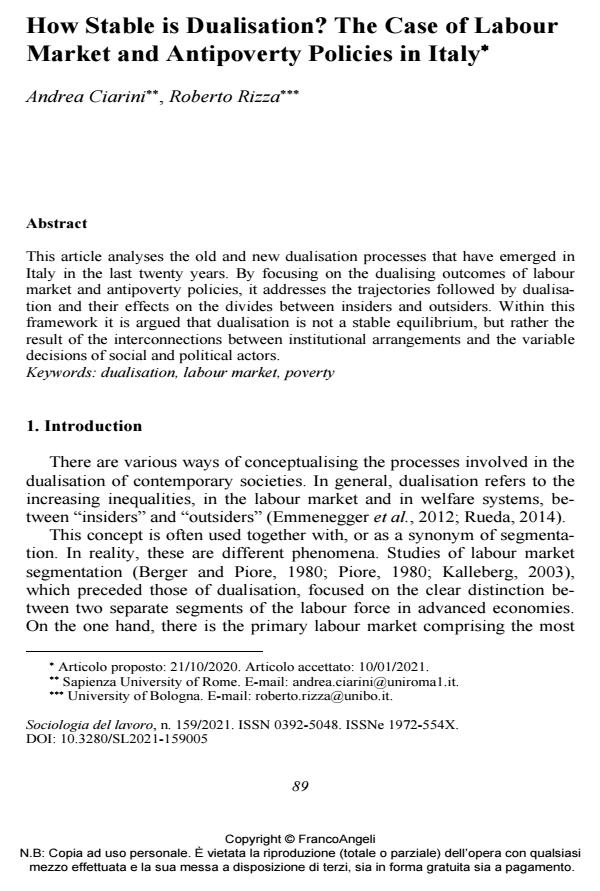Quanto stabile è la dualizzazione? il caso del mercato del lavoro e delle politiche di contrasto alla povertà in Italia
Journal title SOCIOLOGIA DEL LAVORO
Author/s Andrea Ciarini, Roberto Rizza
Publishing Year 2021 Issue 2021/159 Language English
Pages 22 P. 89-110 File size 351 KB
DOI 10.3280/SL2021-159005
DOI is like a bar code for intellectual property: to have more infomation
click here
Below, you can see the article first page
If you want to buy this article in PDF format, you can do it, following the instructions to buy download credits

FrancoAngeli is member of Publishers International Linking Association, Inc (PILA), a not-for-profit association which run the CrossRef service enabling links to and from online scholarly content.
This article analyses the old and new dualisation processes that have emerged in Italy in the last twenty years. By focusing on the dualising outcomes of labour market and antipoverty policies, it addresses the trajectories followed by dualisa-tion and their effects on the divides between insiders and outsiders. Within this framework it is argued that dualisation is not a stable equilibrium, but rather the result of the interconnections between institutional arrangements and the variable decisions of social and political actors.
Keywords: Dualisation, labour market, poverty
- Reyneri E., Pintaldi F. (2013). Dieci domande su un mercato del lavoro in crisi. Bologna: il Mulino.
- Barbieri P., Scherer S. (2005). Le conseguenze sociali della flessibilizzazione del mercato del lavoro in Italia. Stato e mercato, 25(2): 291-322. DOI: 10.1425/2048
- Barbieri P., Cutuli G., Scherer S. (2018). In-work poverty in un mercato del lavoro duale: individualizzazione riflessiva dei rischi sociali o stratificazione della diseguaglianza sociale?. Stato e Mercato, 114(3): 419-460. DOI: 10.1425/9162
- Berger S., Piore M.J. (1980). Dualism and Discontinuity in Industrial Societies. Cambridge Mass: Cambridge University Press.
- Berton F., Richiardi M. and Sacchi S. (2012). The political economy of work, security and flexibility: Italy in comparative perspective. Bristol: The Policy Press.
- Bordogna L., Neri S. (2014). Austerity policies, social dialogue and public services in Italian local government. Transfer, 20(3): 357-371. DOI: 10.1177/102425891453554
- Eichhorst W., Marx P. (2020). How stable is labour market dualism? Reforms of employment protection in nine European countries. European Journal of Industrial Relations, first published online: January 31. -- https://doi.org/10.1177/0959680119899199
- Emmenegger P., Häusermann S., Palier B. and Seeleib-Kaiser M., ed. (2012). The age of dualization: The changing face of inequality in deindustrializing societies. Oxford: Oxford University Press.
- Esping-Andersen G., Regini M., eds. (2000). Why deregulate labour markets?. Oxford: Oxford University Press.
- Gallo G., Sacchi S. (2019). Beneficiari e spesa del reddito di cittadinanza: una stima della misura finale. Roma: Inapp Policy Brief. -- http://oa.inapp.org/xmlui/handle/123456789/364
- Greif A., Laitin D. (2004). A Theory of Endogenous Institutional Change. American Political Science Review, 98(4): 633-652. DOI: 10.1017/S000305540404139
- Hall P., Thelen, K. (2009). Institutional Change in Varieties of Capitalism. Socio-Economic Review, 7(1): 7-34.
- Hassel A. (2014). The paradox of liberalization – Understanding dualism and the recovery of the German political economy. British Journal of Industrial Relations, 52(1): 57-81. -- https://doi.org/10.1111/j.1467-8543.2012.00913.x
- INPS (2020). XIX Rapporto annuale, Roma.
- ISTAT (2020). Nel 2019 in calo la povertà assoluta, 16 giugno.
- Jessoula M., Natili M. and Raitano M. (2019). Italy: Implementing the new minimum income scheme. ESPN Flash Report 2019/35.
- Kalleberg A.L. (2003). Flexible Firms and Labor Market Segmentation: Effects of Workplace Restructuring on Jobs and Workers. Work and Occupations, 30(2): 154-175. DOI: 10.1177/073088840325168
- Palier B., Thelen K. (2010). Institutionalizing dualism: Complementarities and change in France and Germany. Politics & Society, 38(1): 119-148. DOI: 10.1177/003232920935788
- Pavolini E., León M., Guillén A.M. and Ascoli U. (2015). From Austerity to permanent strain? The EU and welfare state reform in Italy and Spain. Comparative European Politics, 13(1): 56-76. -- http://dx.doi.org/10.1057/cep.2014.41
- Pontusson J. (2009). Once Again a Model: Nordic Social Democracy in a Globalized World. Futures of the Left. Durham: Duke University Press.
- Rueda D. (2007). Social democracy inside out: Partisanship and labor market policy in advanced industrialized democracies. Oxford: Oxford University Press.
- Rueda D. (2014). Dualization, crisis and the welfare state. Socio-Economic Review, 12(2): 381-407. -- https://doi.org/10.1093/ser/mwu015
- Saraceno C., Keck W. (2010). Can we identify intergenerational policy regimes in Europe?. European Societies, 12(5): 675-696. -- https://doi.org/10.1080/14616696.2010.483006
- Saraceno C., Benassi D., Morlicchio E. (2020). Poverty in Italy: Features and Drivers in a European Perspective. Bristol: Policy Press.
- Thelen K. (2012). Varieties of capitalism: Trajectories of liberalization and the new politics of social solidarity. Annual Review of Political Science, 15(1): 137-159. -- https://doi.org/10.1146/annurev-polisci-070110-122959
- Thelen K. (2014). Varieties of liberalization and the new politics of social solidarity. Cambridge: Cambridge University Press.
Andrea Ciarini, Roberto Rizza, How Stable is Dualisation? The Case of Labour Market and Antipoverty Policies in Italy in "SOCIOLOGIA DEL LAVORO " 159/2021, pp 89-110, DOI: 10.3280/SL2021-159005